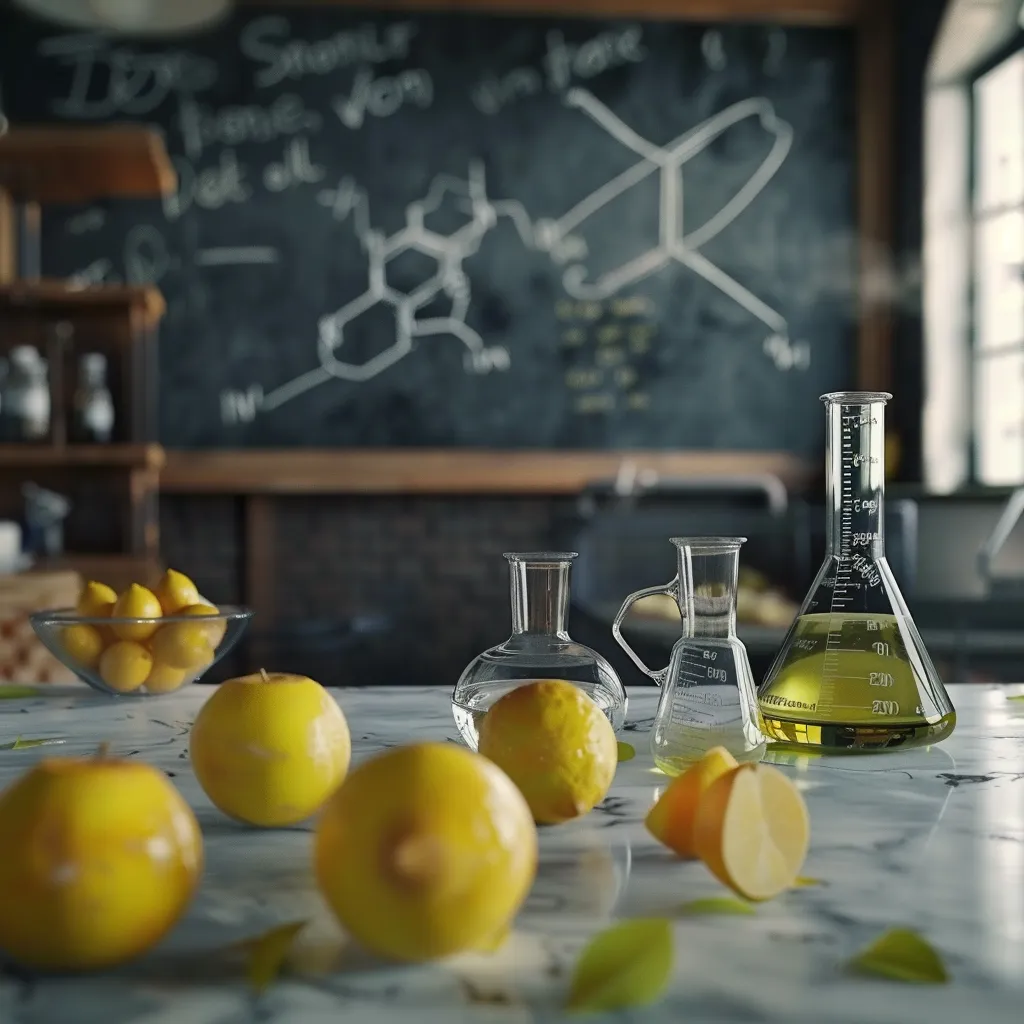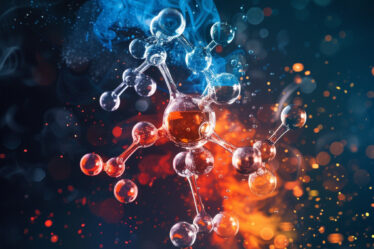
If you’ve ever smelled vinegar or rancid butter, you’ve already encountered carboxylic acids.
Acetic acid, which gives vinegar its sour taste, and butyric acid, responsible for the smell of rancid butter, are both common examples. Carboxylic acids are characterized by a carboxyl group (-COOH), which influences their behavior in chemical reactions.
Let’s explore what makes carboxylic acids unique, how they react, and where you’ll find them in everyday life.
Carboxylic Acid: Quick Summary
Do you just need the basics? Here’s a simple explanation of what carboxylic acids are:
🟠 Carboxylic acids contain the $COOH$ group, giving them acidic properties and playing a role in many biological and industrial processes.
🟠 Common carboxylic acids include methanoic acid, ethanoic acid, and butanoic acid, each having distinct chemical properties.
🟠 Esterification occurs when carboxylic acids react with alcohols, forming esters used in perfumes and flavorings.
🟠 Carboxylic acid can be reduced to primary alcohol and neutralized by base to form carboxylate salt.
🟠 Decarboxylation involves carboxylic acids losing $CO_2$, a reaction often used in organic chemistry synthesis.
If you find butyric, methanoic, and ethanoic acid challenging, don’t worry! Personalized tutoring or interactive chemistry lessons make these concepts more straightforward. Explore more chemistry topics and broaden your knowledge with our free World of Chemistry blogs.
What Are Carboxylic Acids?
Carboxylic acids are organic compounds containing a functional group called a carboxyl group ($-COOH$), made up of a carbonyl ($C=O$) and a hydroxyl ($-OH$) group. This group allows the compound to behave as an acid, releasing a proton ($H^+$) in water. You’ll find carboxylic acids naturally occurring in many biological processes, such as in amino acids and fatty acids.
For instance, butyric acid is found in dairy products, and acetic acid is the main component of vinegar. Carboxylic acids are also essential in metabolism, particularly in the citric acid cycle, which helps convert food into energy in cells.
Common Carboxylic Acids and Their Chemical Properties
Carboxylic acids are organic compounds that contain the $COOH$ functional group, which makes them acidic and reactive. This carboxyl group can easily donate a proton ($H^+$), allowing carboxylic acids to participate in key reactions like neutralization and esterification.
Below, we’ll explore well-known carboxylic acids’ structures and chemical properties.
Methanoic Acid (Formic Acid)
Methanoic acid ($HCOOH$), also known as formic acid, is the simplest carboxylic acid. Its structure comprises a single hydrogen atom attached to the $COOH$ group.
Formic acid is a strong acid known for its reactivity and ability to reduce metals. It occurs naturally in ant venom, serving as a defense mechanism.
Ethanoic Acid (Acetic Acid)
Ethanoic acid ($CH_3COOH$), or acetic acid, has a methyl group ($CH_3$) attached to a carboxyl group. Acetic acid is moderately acidic, and its dissociation in water releases $H^+$ ions.
It’s commonly used in esterification reactions, forming esters with alcohol. Acetic acid is also the primary component of vinegar and is used in food preparation.
Propanoic Acid
Propanoic acid ($C_2H_5COOH$) contains three carbon atoms larger than methanoic and ethanoic acid. Its $COOH$ group can dissociate in water, releasing propionate ions.
Propanoic acid is often used in organic reactions like decarboxylation, where it loses its carboxyl group as carbon dioxide.
Butanoic Acid (Butyric Acid)
Butanoic acid ($C_3H_7COOH$), also known as butyric acid, has a strong, unpleasant odor, often compared to rancid butter. Like other carboxylic acids, its $COOH$ group dissociates in water.
It also reacts with bases to form butyrate salts and is naturally found in dairy products and animal fats.
Citric Acid
Citric acid ($C_6H_8O_7$) is a tricarboxylic acid, meaning it has three $COOH$ groups, which makes it more acidic than other carboxylic acids. It plays a key role in the citric acid cycle in cellular respiration.
Citric acid is also known for forming complexes with metal ions, making it useful in cleaning agents and as a preservative.
Physical Properties of Carboxylic Acids
Due to their $COOH$ functional group, carboxylic acids have unique physical properties. These characteristics, like boiling points, solubility, and acidity, help explain how carboxylic acids behave in different chemical environments.
Boiling Points in Carboxylic Acids
Carboxylic acids generally have higher boiling points compared to other organic compounds of similar size. This is due to the hydrogen bond between carboxylic acid molecules, where the $OH$ group of one molecule interacts with the $C=O$ group of another.
The formation of dimers (pairs of molecules connected by hydrogen bonds) increases the energy required to turn the liquid into a gas. For example, ethanoic acid (acetic acid) has a higher boiling point than ethanol, even though both are similar in size, because of this dimerization effect.
Solubility of Carboxylic Acids
The solubility of carboxylic acids in water depends on the carbon chain length. Smaller carboxylic acids, like methanoic acid (formic acid) and ethanoic acid, are highly water-soluble because the polar $COOH$ group forms strong hydrogen bonds with water.
However, as the carbon chain gets longer (like in butanoic acid), the non-polar alkyl group becomes more prominent, making the molecule less soluble in water but more soluble in organic solvents such as ethanol or benzene.
Acidity of Carboxylic Acids
Carboxylic acids are weak acids because they partially dissociate in water, releasing a proton ($H^+$) from the $COOH$ group. The resulting carboxylate ion ($RCOO^-$) is stabilized by resonance, which spreads the negative charge across both the oxygen atoms.
Acidity increases if electron-withdrawing groups (like chlorine) are near the $COOH$ group, as they stabilize the carboxylate ion further, making the acid more likely to donate a proton.
Chemical Reactions of Carboxylic Acids
Carboxylic acids are highly reactive because of their $COOH$ group, allowing them to participate in various important chemical reactions.
These reactions involve breaking or modifying the carboxyl group to form new products. Below are the most common chemical reactions associated with carboxylic acids.
Esterification
Esterification is when a carboxylic acid reacts with an alcohol to form an ester. This reaction occurs in the presence of an acid catalyst, typically sulfuric acid ($H_2SO_4$).
In esterification, the hydroxyl group ($-OH$) of the carboxylic acid combines with the hydrogen ($H$) from the alcohol, releasing water ($H_2O$).
For example:
$CH_3COOH + CH_3CH_2OH \rightarrow CH_3COOCH_2CH_3 + H_2O$
This forms ethyl ethanoate (an ester) and water. Esters are widely used in organic chemistry and for their pleasant fragrances.
Reduction to Alcohols
Carboxylic acids can be reduced to primary alcohols using reducing agents like lithium aluminum hydride ($LiAlH_4$).
The reduction converts the $COOH$ group into primary alcohol ($-OH$) by breaking the $C=O$ double bond and adding hydrogen atoms.
For example:
$CH_3COOH \xrightarrow{LiAlH_4} CH_3CH_2OH$
In this reaction, ethanoic acid is reduced to ethanol. This process is crucial in producing alcohols for pharmaceuticals and organic synthesis.
Neutralization with Bases
Carboxylic acids react with strong bases, like sodium hydroxide ($NaOH$), to form carboxylate salts and water.
The $H^+$ ion from the acid reacts with the $OH^-$ from the base.
For instance:
$CH_3COOH + NaOH \rightarrow CH_3COONa + H_2O$
This reaction produces sodium ethanoate, a type of carboxylate salt. Neutralization reactions like these are important in soap production and other industrial processes.
Decarboxylation
In decarboxylation, carboxylic acids lose carbon dioxide ($CO_2$) when heated. This reaction removes the carboxyl group from the molecule, typically forming hydrocarbons.
For example, heating sodium ethanoate leads to the formation of methane:
$CH_3COONa \xrightarrow{\text{heat}} CH_4 + CO_2$
This reaction is useful in shortening carbon chains in organic synthesis.
Nomenclature of Carboxylic Acids
Carboxylic acids follow specific IUPAC rules for naming, which help chemists describe their structures clearly. The name of a carboxylic acid is based on the longest carbon chain that includes the carboxyl group ($COOH$). The suffix “-oic acid” is always added to the root name of the parent hydrocarbon, replacing the “-e” in alkanes.
Naming Carboxylic Acids
To name a carboxylic acid using the IUPAC system, follow these steps:
- Identify the longest carbon chain that includes the carboxyl group. This will form the basis of the name.
- Replace the -e suffix of the corresponding alkane (methane, ethane, etc.) with -oic acid. For example, methane becomes methanoic acid, and propane becomes propanoic acid.
- The carbon in the $COOH$ group is always carbon 1. This means that any substituents (additional groups attached to the chain) are numbered starting from this carbon.
- If there are side chains or functional groups, their positions are indicated by the number of carbon they are attached to. These are written as prefixes in alphabetical order before the main name.
Naming Carboxylic Acids Example
- Methanoic Acid: The simplest carboxylic acid, also called formic acid. It has just one carbon in the chain, so it’s named methanoic acid.
- Ethanoic Acid: Commonly known as acetic acid. It has two carbons, one part of the carboxyl group, so it is named ethanoic acid.
Common Names vs. IUPAC Names
Here’s a table comparing the common names and IUPAC names of well-known carboxylic acids:
| Number of Carbons | Common Name | IUPAC Name | Formula |
| 1 | Formic Acid | Methanoic Acid | HCOOH |
| 2 | Acetic Acid | Ethanoic Acid | CH₃COOH |
| 3 | Propionic Acid | Propanoic Acid | CH₃CH₂COOH |
| 4 | Butyric Acid | Butanoic Acid | CH₃(CH₂)₂COOH |
| 5 | Valeric Acid | Pentanoic Acid | CH₃(CH₂)₃COOH |
| 6 | Caproic Acid | Hexanoic Acid | CH₃(CH₂)₄COOH |
| 7 | Enanthic Acid | Heptanoic Acid | CH₃(CH₂)₅COOH |
| 8 | Caprylic Acid | Octanoic Acid | CH₃(CH₂)₆COOH |
| 9 | Pelargonic Acid | Nonanoic Acid | CH₃(CH₂)₇COOH |
| 10 | Capric Acid | Decanoic Acid | CH₃(CH₂)₈COOH |
Advance Your Knowledge of Carboxylic Acids
Carboxylic acids are a central part of organic chemistry and are involved in important reactions like esterification and neutralization. Their unique structure gives them properties that connect to many other compounds. If you’re still unsure about how they work, don’t hesitate to ask for help.
Are carboxylic acids tricky for you? A qualified chemistry instructor can explain complex topics in a way that makes sense to you, making organic and inorganic chemistry understandable and enjoyable.
Search for a tutor using phrases like “chemistry tutor Edinburgh” or “chemistry teacher Liverpool” on platforms like meet’n’learn. You’ll find someone who can tailor lessons to your needs.
If you prefer learning in a group, search for “chemistry classes Leeds” or “chemistry lessons London” online. The search will lead you to chemistry tutoring nearby.
Carboxylic Acid: Frequently Asked Questions
1. What is a carboxylic acid?
A carboxylic acid is an organic compound containing a carboxyl group ($COOH$), giving it acidic properties.
2. How are carboxylic acids named?
Carboxylic acids are named using the IUPAC system by replacing the “-e” in alkanes with “-oic acid.”
3. What is esterification in carboxylic acids?
Esterification is the reaction between a carboxylic acid and an alcohol to form an ester and water.
4. What happens when carboxylic acids react with bases?
When carboxylic acids react with bases, they form carboxylate salts and water.
5. What is the difference between methanoic acid and ethanoic acid?
Methanoic acid (formic acid) has one carbon atom, while ethanoic acid (acetic acid) has two.
6. Can carboxylic acids be reduced?
Yes, carboxylic acids can be reduced to primary alcohols using reducing agents like lithium aluminum hydride.
7. What is decarboxylation of carboxylic acids?
Decarboxylation is the process where a carboxylic acid loses $CO_2$ when heated.
8. Where are carboxylic acids found in nature?
Carboxylic acids are found in many natural substances, including amino acids, fatty acids, and citric acid in fruits.
References:
1. Khan Academy
2. Britannica
3. Wikipedia



